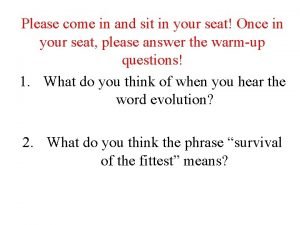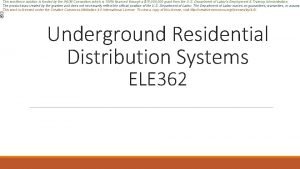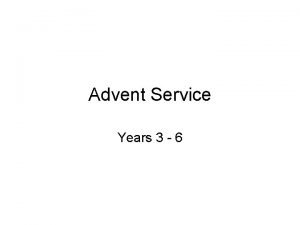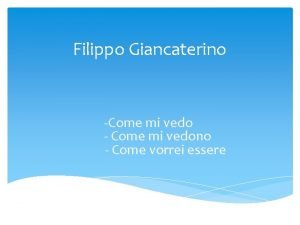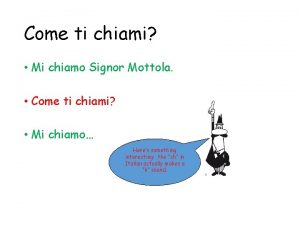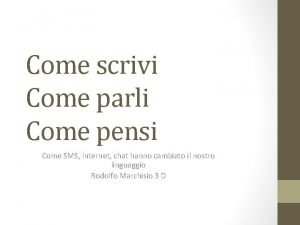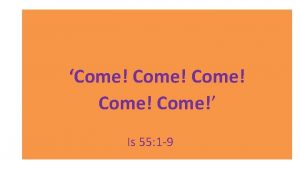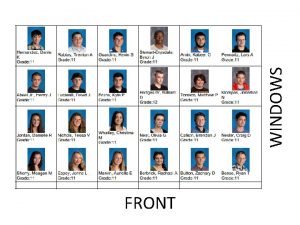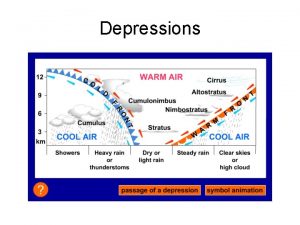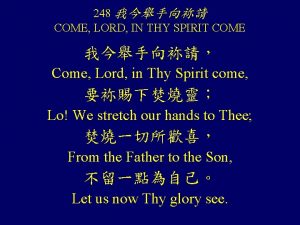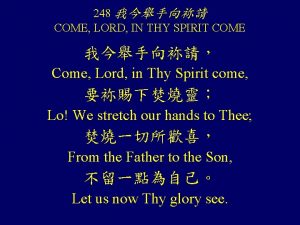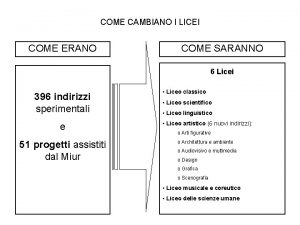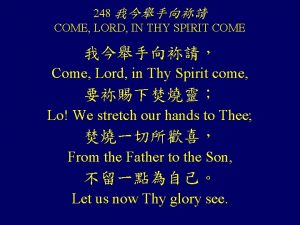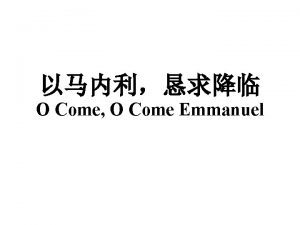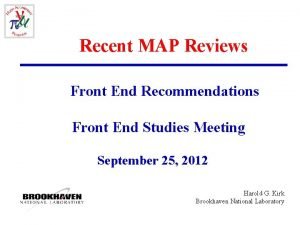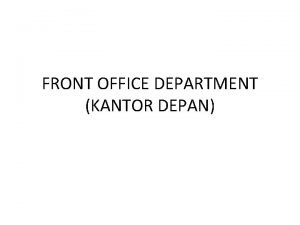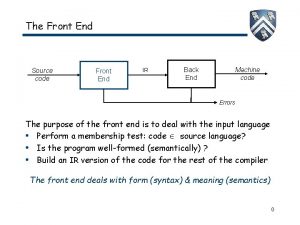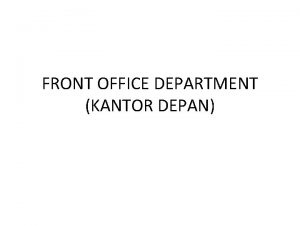Control systems Come sit in the front so















































- Slides: 47

Control systems Come sit in the front so you’ll see and hear the demo KON-C 2004 Mechatronics Basics Tapio Lantela, Nov 14 th, 2017

Lecture topics System modeling and response PID controller Servo motors

Mechatronic device Communication Sensors User Interface Signal Processing Inputs Control Computer Actuators ”Process” Actuator Drives Outputs

Example

Triple inverted pendulum No actuators in rotational joints, only angle measurement

Unstable controller

System response

System Input System Output

Mathematical models of systems

Second order system: DC motor

Step response of a system Overshoot Steady state Rise time Settling time

Parameters

System damping

Stability System is stable when bounded input always causes a bounded output Problems are caused by - Inherently unstable systems - Unstable controller • Delay in control loop • Too high control gains • Positive feedback http: //www. roymech. co. uk/Related/Control/Stability. html

Resonance

Control systems

Requirements for a control system The output of the process follows the reference with - Steady state accuracy - Transient accuracy o Time constant, overshoot - Stability And the controller requires reasonable - Computational effort - Amount of knowledge of the process - Effort to tune

Open loop control Controlling the process without a knowledge of its state Controller always stable Does not reject disturbances - External forces - Aging of devices (change in friction) etc. - Changes in environment (temperature etc) No sensors required http: //abrobotics. tripod. com/Control. Laws/cloverview. htm

Closed loop (feedback) control Modifying the control signal using information of the current output of the process Negative feedback stabilizes system Positive feedback causes instability

Feed forward control Modifying the control signal according to some external parameters http: //science-hamza. blogspot. fi/2011/02/feed-forward-control-loops. html

Bang bang controller Actuator at full positive or negative power Very simple and often fastest possible response In some cases requires a system model for accuracy Requires hysteresis to limit switching https: //sites. google. com/site/tuftsceeok 12 projects/lesson-plans/proportional-controller

PID controller

Back to the example

PID controller Proportional, Integral and Derivative terms

PID controller (P term) Output proportional to error signal Large gain Kp -> fast response, overshoot, oscillation Small gain Kp -> slow response, large steady-state error

PID controller (I term) Output proportional to time integral of error - Makes steady state error go to zero Large KI -> error decreases quickly, overshoot, oscillation Small KI -> error decreases slowly

PID controller (D term) Output proportional to change rate of the error - Kd can dampen the response If signal is noisy Kd may increase the interference

Parameter effects Overshoot Steady state error Stability KP + - - KI + -> 0 - KD - - +/-

Parameter effects https: //en. wikipedia. org/wiki/Control_system

PID controller tuning Finding the right gains - Experimenting with a real system – might be dangerous • Apply input and observe - Experimenting with a system model – might be tedious • Simulink model – curves – adjust gains - Iterative optimization with a system model – requires cost function • For example a Simulink model with Matlab optimization functions - Analytical optimization with mathematical system model – might be difficult • Transfer function – calculus

Example: Microcontroller code for PI controller if(PID_on){ reference = read_adc(0)/4; error = reference-speed; proportional = P*error; integral = integral + I*error; control = proportional+integral; if(control<0){direction = 1; }else{direction = 0; } } PORTB. 3 = direction; OCR 1 A = control; //Read reference from a potentiometer //Calculate error //Proportional part of control //Integral part of control //Controller output //Choose motor direction //Write to direction register //Write to PWM register

Actuator range and rate limitations Real actuators have range and speed limitations Actuator saturates -> modify control law Anti-windup compensator - Limits integral growth Controller output Actuator output http: //brettbeauregard. com/blog/2011/04/improving-the-beginner%E 2%80%99 s-pid-reset-windup/

Analog vs digital controllers Controllers implemented with digital devices do not work continuously Analog controller can be implemented with operational amps - High frequency, integration differentiation, summing etc - Most controllers digital, some vefy fast control loops analog Results slightly different in analog and digital controllers Slightly different analysis methods

Control rate In digital technology, not even time is continuous All tasks are done at certain intervals - Measurements are either averaged or momentary - Control algorithm calculated at constant and small enough control intervals Control rate depends on time constant of the system - Rise time from one state to another minimum 5 -10 control loops • For a motor for example every 10 ms is often enough

PID demo time

PID position control demo

Other controllers Model-based control - Using a model of the system to predict its behaviour Adaptive control - Modifying controller parameters according to output Optimal control - Optimizing a controller to minimize a cost function Robust control - Designing a controller that works with disturbances Fuzzy control - Intuitive rule based controllers

Servo motors

Servomotor control system Goal: - Motor that spins at the required speed regardless of load or disturbances • Velocity feedback - Actuator that keeps the required position regardless of load or disturbances • Position feedback

Servo control systems Analogue control system Digital control system Lawrence & Mauch, Real-Time Microcomputer System Design

Cascade control Control loop inside a control loop - Outer loop for speed control - Inner for torque (current)

Sensors for a servo motor Encoders - Incremental or absolute - Optical, magnetic etc. Resolvers & Synchros - Rotating transformers which measure position Tachogenerators - ”Inverse motor”, measures rotating speed Potentiometers - Variable voltage divider

Motors for servo systems Many designs: DC (brushed or brushless), AC Integrated feedback sensors Ability to tolerate short term overloads Low inductance - Small electric time constant Low rotor inertial mass - Small mechanical time constant http: //www. ustudy. in/node/5789 http: //www. exlar. com/press_releases/1868

Example: RC-servo Built in components: - Motor Reduction gear Potentiometer Control circuit Driver circuit

The control circuit of the RC servo Output shaft

Application examples Machining centers - Rotation to linear motion with screws - Positioning accuracy 0. 005 mm Industrial robots - E. g. ABB IRB 7600 • Payload up to 630 kg • Positioning accuracy 0. 1 mm

Summary A controller increases the performance of a system Feedback control is used to reject disturbances Feedback control can stabilize unstable systems - Feedback control can also destabilize stable systems A PID controller is easy to implement - Every mechatronic engineer should understand it Servomotor is a feedback controlled motor - Servomotor is not a motor type
 Come in come in and sit down
Come in come in and sit down Come in come in and sit down
Come in come in and sit down Greensboro sit ins significance
Greensboro sit ins significance Come rico come sano
Come rico come sano Please come in and have a seat
Please come in and have a seat Please come in and sit
Please come in and sit Come to the table hymn
Come to the table hymn Dead front vs live front transformer
Dead front vs live front transformer Warm front diagram
Warm front diagram Contents page magazine
Contents page magazine Come holy spirit come inflame our souls with love
Come holy spirit come inflame our souls with love Hey come on out short story pdf
Hey come on out short story pdf Come thou fount come thou king lyrics
Come thou fount come thou king lyrics Past tense of sh
Past tense of sh Emmanuel son of god
Emmanuel son of god Come mi chiamo
Come mi chiamo Come lord jesus come and be born in our hearts
Come lord jesus come and be born in our hearts Come home come home jesus is calling
Come home come home jesus is calling Come mi vedo
Come mi vedo Come on come on turn your radio on
Come on come on turn your radio on Come mi chiamo come mi chiamo
Come mi chiamo come mi chiamo Lista de verbos infinitive past simple past participle
Lista de verbos infinitive past simple past participle Hình ảnh bộ gõ cơ thể búng tay
Hình ảnh bộ gõ cơ thể búng tay Slidetodoc
Slidetodoc Bổ thể
Bổ thể Tỉ lệ cơ thể trẻ em
Tỉ lệ cơ thể trẻ em Voi kéo gỗ như thế nào
Voi kéo gỗ như thế nào Tư thế worms-breton
Tư thế worms-breton Chúa yêu trần thế alleluia
Chúa yêu trần thế alleluia Các môn thể thao bắt đầu bằng tiếng bóng
Các môn thể thao bắt đầu bằng tiếng bóng Thế nào là hệ số cao nhất
Thế nào là hệ số cao nhất Các châu lục và đại dương trên thế giới
Các châu lục và đại dương trên thế giới Cong thức tính động năng
Cong thức tính động năng Trời xanh đây là của chúng ta thể thơ
Trời xanh đây là của chúng ta thể thơ Cách giải mật thư tọa độ
Cách giải mật thư tọa độ Làm thế nào để 102-1=99
Làm thế nào để 102-1=99 Phản ứng thế ankan
Phản ứng thế ankan Các châu lục và đại dương trên thế giới
Các châu lục và đại dương trên thế giới Thể thơ truyền thống
Thể thơ truyền thống Quá trình desamine hóa có thể tạo ra
Quá trình desamine hóa có thể tạo ra Một số thể thơ truyền thống
Một số thể thơ truyền thống Bàn tay mà dây bẩn
Bàn tay mà dây bẩn Vẽ hình chiếu vuông góc của vật thể sau
Vẽ hình chiếu vuông góc của vật thể sau Biện pháp chống mỏi cơ
Biện pháp chống mỏi cơ đặc điểm cơ thể của người tối cổ
đặc điểm cơ thể của người tối cổ Giọng cùng tên là
Giọng cùng tên là Vẽ hình chiếu đứng bằng cạnh của vật thể
Vẽ hình chiếu đứng bằng cạnh của vật thể Tia chieu sa te
Tia chieu sa te





